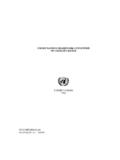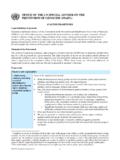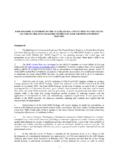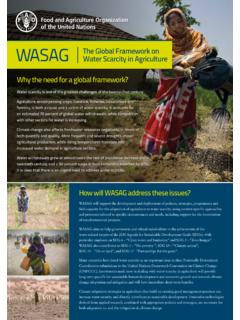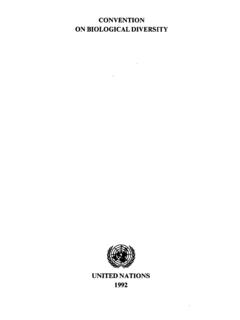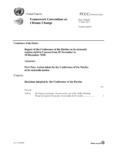Transcription of WHO FRAMEWORK CONVENTION ON TOBACCO …
1 World Health Organization Geneva, Switzerland WHO FRAMEWORK CONVENTION ON TOBACCO control World Health Organization WHO Library Cataloguing-in-Publication Data WHO FRAMEWORK CONVENTION on TOBACCO control . - supply and distribution industry - legislation smoke pollution - prevention and control use cessation Health Organization. ISBN 92 4 159101 3 (LC/NLM classification: HD ) World Health Organization 2003, updated reprint 2004, 2005 All rights reserved. Publications of the World Health Organization can be obtained from WHO Press, World Health Organization, 20 Avenue Appia, 1211 Geneva 27, Switzerland (tel: +41 22 791 2476; fax: +41 22 791 4857; email: Requests for permission to reproduce or translate WHO publications whether for sale or for noncommercial distribution should be addressed to WHO Press, at the above address (fax: +41 22 791 4806.))
2 Email: The designations employed and the presentation of the material in this publication do not imply the expression of any opinion whatsoever on the part of the World Health Organization concerning the legal status of any country, territory, city or area or of its authorities, or concerning the delimitation of its frontiers or boundaries. Dotted lines on maps represent approximate border lines for which there may not yet be full agreement. The mention of specific companies or of certain manufacturers products does not imply that they are endorsed or recommended by the World Health Organization in preference to others of a similar nature that are not mentioned. Errors and omissions excepted, the names of proprietary products are distinguished by initial capital letters.
3 All reasonable precautions have been taken by the World Health Organization to verify the information contained in this publication. However, the published material is being distributed without warranty of any kind, either express or implied. The responsibility for the interpretation and use of the material lies with the reader. In no event shall the World Health Organization be liable for damages arising from its use. Printed by the WHO Document Production Services, Geneva, Switzerland. WHO FRAMEWORK CONVENTION on TOBACCO control iii Table of Contents v WHO FCTC 1 1 Part I: 4 Article 1 Use of terms .. 4 Article 2 Relationship between this CONVENTION and other agreements and legal instruments .. 5 Part II: Objective, guiding principles and general 5 Article 3 Objective.
4 5 Article 4 Guiding Principles .. 5 Article 5 General Obligations .. 7 Part III: Measures relating to the reduction of demand for 7 Article 6 Price and tax measures to reduce the demand for TOBACCO .. 7 Article 7 Non-price measures to reduce the demand for TOBACCO .. 8 Article 8 Protection from exposure to TOBACCO smoke .. 8 Article 9 Regulation of the contents of TOBACCO products .. 9 Article 10 Regulation of TOBACCO product disclosures .. 9 Article 11 Packaging and labelling of TOBACCO 9 Article 12 Education, communication, training and public 10 Article 13 TOBACCO advertising, promotion and sponsorship .. 11 Article 14 Demand reduction measures concerning TOBACCO dependence and cessation .. 13 Part IV: Measures relating to the reduction of the supply of 13 Article 15 Illicit trade in TOBACCO products.
5 13 Article 16 Sales to and by 15 Article 17 Provision of support for economically viable alternative activities .. 16 Part V: Protection of the 16 Article 18 Protection of the environment and the health of 16 Part VI: Questions related to 17 Article 19 Liability .. 17 Part VII: Scientific and technical cooperation and communication of 17 Article 20 Research, surveillance and exchange of information .. 17 Article 21 Reporting and exchange of 19 Article 22 Cooperation in the scientific, technical and legal fields and provision of related expertise .. 20 Part VIII: Institutional arrangements and financial 21 Article 23 Conference of the 21 Article 24 Secretariat .. 22 WHO FRAMEWORK CONVENTION on TOBACCO control iv Article 25 Relations between the Conference of the Parties and intergovernmental Article 26 Financial resources.
6 23 Part IX: Settlement of Article 27 Settlement of disputes ..24 Part X: Development of the Article 28 Amendments to this Article 29 Adoption and amendment of annexes to this Part XI: Final Article 30 Reservations ..26 Article 31 Withdrawal ..26 Article 32 Right to vote ..27 Article 33 Protocols ..27 Article 34 Article 35 Ratification, acceptance, approval, formal confirmation or accession ..28 Article 36 Entry into Article 37 Article 38 Authentic Annex 1: WHA Resolution WHO FRAMEWORK CONVENTION on TOBACCO Annex 2: History of the WHO FCTC WHO FRAMEWORK CONVENTION on TOBACCO control v FOREWORD The WHO FRAMEWORK CONVENTION on TOBACCO control (WHO FCTC) is the first treaty negotiated under the auspices of the World Health Organization.
7 The WHO FCTC is an evidence-based treaty that reaffirms the right of all people to the highest standard of health. The WHO FCTC represents a paradigm shift in developing a regulatory strategy to address addictive substances; in contrast to previous drug control treaties, the WHO FCTC asserts the importance of demand reduction strategies as well as supply issues. The WHO FCTC was developed in response to the globalization of the TOBACCO epidemic. The spread of the TOBACCO epidemic is facilitated through a variety of complex factors with cross-border effects, including trade liberalization and direct foreign investment. Other factors such as global marketing, transnational TOBACCO advertising, promotion and sponsorship, and the international movement of contraband and counterfeit cigarettes have also contributed to the explosive increase in TOBACCO use.
8 From the first preambular paragraph, which states that the Parties to this CONVENTION [are] determined to give priority to their right to protect public health , the WHO FCTC is a global trend-setter. The core demand reduction provisions in the WHO FCTC are contained in articles 6-14: Price and tax measures to reduce the demand for TOBACCO , and Non-price measures to reduce the demand for TOBACCO , namely: Protection from exposure to TOBACCO smoke; Regulation of the contents of TOBACCO products; Regulation of TOBACCO product disclosures; Packaging and labelling of TOBACCO products; Education, communication, training and public awareness; TOBACCO advertising, promotion and sponsorship; and, Demand reduction measures concerning TOBACCO dependence and cessation.
9 The core supply reduction provisions in the WHO FCTC are contained in articles 15-17: Illicit trade in TOBACCO products; Sales to and by minors; and, Provision of support for economically viable alternative activities. Another novel feature of the CONVENTION is the inclusion of a provision that addresses liability. Mechanisms for scientific and technical cooperation and exchange of information are set out in Articles 20-22. WHO FRAMEWORK CONVENTION on TOBACCO control vi The WHO FCTC opened for signature on 16 June to 22 June 2003 in Geneva, and thereafter at the United Nations Headquarters in New York, the Depositary of the treaty, from 30 June 2003 to 29 June 2004. The treaty, which is now closed for signature, has 168 Signatories, including the European Community, which makes it the most widely embraced treaties in UN history.
10 Member States that have signed the CONVENTION indicate that they will strive in good faith to ratify, accept, or approve it, and show political commitment not to undermine the objectives set out in it. Countries wishing to become a Party, but that did not sign the CONVENTION by 29 June 2004, may do so by means of accession, which is a one-step process equivalent to ratification. The CONVENTION entered into force on 27 February 2005 -- 90 days after it has been acceded to, ratified, accepted, or approved by 40 States. Beginning on that date, the forty Contracting Parties are legally bound by the treaty's provisions. For each State that ratifies, accepts or approves the CONVENTION or accedes thereto after the conditions set out in paragraph 1 of Article 36 for entry into force have been fulfilled, the CONVENTION shall enter into force on the ninetieth day following the date of deposit of its instrument of ratification, acceptance, approval or accession.











